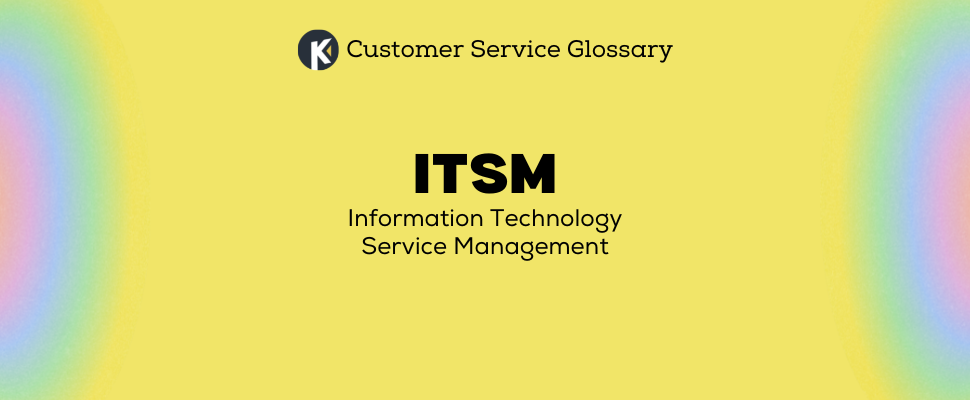
What is ITSM ?
ITSM (IT Service Management) is the concept of delivering IT as a service. ITSM is responsible for the end-to-end management of designing, creating, delivering, supporting and managing IT services that enable employees to do their jobs. ITSM means continually improving IT services so they keep pace with the changing needs of the business.
Information Technology (IT) is an indispensable part of the operations of modern business. The ability to manage and maintain the organization’s IT assets infrastructure and services is the responsibility of the IT team, who may adopt various frameworks and processes in the pursuit of this goal.
If IT systems and services are down, this severely hampers the productivity of the organization as a whole, because employees can’t get on with their work. ITSM, therefore, is heavily involved with ensuring that employees have the processes and tools that they need to operate at maximum efficiency and continue serving the needs of the business.
ITSM, in short, keeps the lights on in the business. It takes full responsibility for managing IT services so the business can continue to operate and thrive, ready to conduct mission-critical activities. It is more than just a service desk, waiting passively to receive service requests.
Some are confused about exactly what ITSM is, its benefits, and relationship to ITIL. We’ll set out to demystify these concepts in this post.
What is ITSM
ITSM (IT Service Management) is the concept of delivering IT as a service. ITSM is responsible for the end-to-end management of designing, creating, delivering, supporting and managing IT services that enable employees to do their jobs. ITSM means continually improving IT services so they keep pace with the changing needs of the business.
IT Service Management is much more than just “IT support” – it is responsible for the entire lifecycle of IT services, including troubleshooting problems, change management, and service delivery. It means focusing on more than just the tools needed for IT services, and puts people at the heart of ITSM.
IT Service Management aligns the goals of the IT team with the objectives of the business as a whole. ITSM uses people, processes and technology to provide tangible business value and reduce operating costs.
ITSM processes are:
- Change Management – ensures that standard processes are followed when implementing changes with IT infrastructure, which may include delivering new services, managing current services, or fixing problems in programs.
- Problem Management – the process of locating and dealing with the causes of incidents that occur within the IT service, and eliminating the root cause so the problem doesn’t crop up again.
- Incident Management – the process that responds to and handles an unplanned incident that interrupts IT service delivery, and returns the service to its functional state.
- IT Asset Management – the process of managing an organization’s IT assets and ensuring they are deployed, maintained, developed and discarded at the appropriate time.
- Knowledge Management – the process of capturing, maintaining, sharing and preserving the internal IT knowledge of an organization.
- Service Request Management – the recurring process of handling customer requests such as new hardware or software updates. It can mean providing self-service for customers and automating away certain tasks.
ITSM vs ITIL
ITIL (Information Technology Infrastructure Library) is part of ITSM but ITSM is not necessarily ITIL. ITIL is one of a number of frameworks that can be used when delivering IT Service Management and offers a number of best practices and processes. It was developed by the UK government in the 1980s as the use of IT was rapidly spreading.
ITSM refers to the service delivery of IT while ITIL describes exactly how these processes can be executed. All organizations will use ITSM to some degree but not all of them will use ITIL, because they might adopt an alternative approach. Often businesses combine multiple frameworks for delivering ITSM, especially in the enterprise with multiple arms of the business that have differing needs. Another example of an ITSM framework is the Microsoft Operations Framework (MOF).
ITSM benefits
Reduced operating costs
When your business is more coordinated about your IT processes using ITSM, less money is wasted on redundant tasks and avoidable issues. ITSM takes a birds-eye view of the entire lifecycle of IT service management and attempts to implement solutions that will bring more value to the business.
For example, instead of purchasing storage for each employee on an individual level, ITSM can save a business money by purchasing in bulk and distributing among employees. Or, the business may be continuing a subscription to a particular application, but it turns out that no one is using it. ITSM can then review whether the business should continue this subscription or whether the budget would be better spent elsewhere.
When businesses make smart decisions about where to spend their budget as a result of ITSM, operating costs are significantly reduced.
Better productivity for employees
When end-users or customers have their needs better served by ITSM, they can do a much better job because IT is not hampering them. Customers have access to all of the tools necessary and they can simply focus on generating value for the business.
Individual employees are unlikely to be IT experts, but your ITSM practitioners can recommend improvements that will help with their productivity. They may implement a mass upgrade to the system so your customers are working with the latest software or ensure that appropriate security protocols are being followed.
IT doesn’t have to be a confusing subject for employees. ITSM professionals can share their expertise to boost productivity and effectiveness.
Prevents recurring problems
Because ITSM gets to the root causes of problems, customers suffer less from avoidable bugs and downtimes that prevent them getting on with their work. Instead of just troubleshooting a particular issue, ITSM looks at the bigger picture to find out how a recurring problem can be prevented. This means that less valuable time is wasted on issues that could be avoided.
ITSM takes responsibility for the overall functioning of the business and aspires towards an ideal state of operativeness.
Creates more value for the organization
Instead of wasting money struggling with legacy systems, ITSM can focus on generating more value for the business by ensuring that proper ITSM processes are in place. It takes a proactive approach by implementing such practices as Knowledge Management which records the knowledge of the business for future use. IT personnel are much more effective when dealing with customers because they have access to the organization’s knowledge base.
Since ITSM is focused on creating value, this can justify expanding the IT department and investing more resources.
Prioritizes people over things
ITSM places an emphasis on the end-users of the services rather than the ITSM processes themselves. Because ITSM builds its systems around customers, this results in a better customer experience and happier customers overall. Since customers are prioritized, they are more receptive to changes in culture and respond well to instructions from the IT department.
One way that people are emphasized in ITSM is through the delivery of self-service, which enables customers to solve their own problems. ITSM consciously allocates resources to improve the experience of customers instead of passively reacting to issues.
When systems are designed around customers, this increases the likelihood of adoption among the workforce.
React more quickly to major incidents and prevent future ones
ITSM is best-placed to react quickly to major incidents such as company-wide outages because they have crisis plans in place that help them deal with the fall-out. IT departments are better able to coordinate and deal with the crisis, as well as take steps to ensure the major incident doesn’t happen again in the future.
If ITSM teams can respond rapidly to disruptive events, this minimizes the business impact and prevents a loss of revenue.
Empower customers with self-service
Without ITSM, the traditional model of IT support is the customer contacts the service desk and opens a ticket. With ITSM, customers are empowered to self-serve with self service portals that are made available instead of a help desk agent.
This results in reduced ticket costs and more satisfied customers who are able to resolve problems instantly instead of waiting for an answer. When customers learn to consult self-service resources, this leads to behavior change for the future as customers learn to resolve problems themselves.
Customers that take advantage of self-service resources are more educated and empowered, resulting in fewer issues and tickets to the support team in the future.
ITSM best practices
Put people over processes
As we’ve already mentioned, an ITSM best practice is to put people over processes. This means first thinking about the end users of your services who will benefit from IT capabilities and what will be best for them. If you start with ITSM processes first, you end up with processes that are ill-fitting for the needs of your user base.
The needs of your users should be aligned with key business goals. This means that ITSM processes, applications and systems are all working in harmony to further the objectives of the business, which are innately people-focused.
Companies who adopt ITSM should ensure that their people can flourish and use technology as a means to an end when they contact the service desk.
Continuous improvement of IT effectiveness
ITSM regularly evaluates the effectiveness of ITSM processes and identifies where changes can be made to improve efficiency. ITSM professionals will conduct regular reports and gather feedback, making recommendations for the organization.
Every company is different, and has unique needs and requirements. ITSM evolves to fit the organization and continually adapt to change, not being something that you install once and continues to run without maintenance.
When businesses continuously evaluate the effectiveness of their processes with continual service improvement, they can build upon past experience and find new solutions.
Track key performance metrics with available data
There is no shortage of available data that IT professionals can analyze performance and assess the effectiveness of their processes and practices. Key performance metrics provide valuable insights into services and check how well they are serving the business’s customers.
Without data, ITSM departments are simply implementing programs without finding out whether they actually serve the organization’s needs. You can’t tell whether your IT team is meeting its targets and whether customer support has been successful.
Key metrics should be regularly tracked and assessed in order to report back on the functioning of the business.
Automate repeatable processes
When humans are responsible for executing tasks this opens up room for more errors. Small mistakes can often lead to significant losses for the business. The answer to this is to automate manual and repetitive tasks so that ITSM professionals can focus their effort on more value-creating tasks for the business.
When you eliminate errors and free your staff up for vital tasks, this results in massive efficiency gains for the business. Automations are another way that ITSM can reduce costs within the organization and raise the morale of your IT support team.
It’s important to carefully identify what ITSM processes should be automated, because inefficiencies will only multiply otherwise.
Focus on delivering great customer service
ITSM prioritizes the end user and ensures that they benefit from a great experience. ITSM should design its services with the customer in mind and ensure that customers are always receiving the highest standard of customer service when they contact the service desk.
This means resolving problems as quickly as possible and taking steps to make sure that they don’t recur. It means being understanding of the fact that customers don’t always have the language to explain their IT issues and being able to accurately troubleshoot and diagnose.
Great customer service will increase trust in IT within your organization and result in mutually beneficial relationships with enhanced customer satisfaction.
Prepare for culture change
Implementing ITSM in a company requires a complete culture for employees who are the end users of the services. Employees need to be prepared for ITSM or the initiative will probably be unsuccessful. They should be encouraged to see the benefits of ITSM and how it will positively impact their ways of working.
ITSM will undoubtedly require altering habitual behaviors and learning to adapt to the demands of IT services. The new way of working will need to be communicated to end-users to ensure they are adequately equipped to keep pace.
Successfully embedding ITSM in organizational culture will result in a happier and more productive workforce, both inside the IT team and out.
Wrapping up
ITSM takes your business beyond traditional IT support to a more proactive approach to delivering IT services. ITSM brings real business value and becomes a way to reduce costs, as it emphasizes the customer and their needs when designing IT processes. In ITSM, there are no unnecessary processes, and performance is evaluated to make sure that every practice of the department is benefiting the business.
ITSM differentiates your business from the competition by ensuring that your IT services are unparalleled. Instead of hampering the operations of your business, IT becomes a function that drives the business forward and reaches new heights of productivity.
Join 150+ teams that are sharing inboxes with us
The easiest way to upgrade your shared Gmail account. There’s no credit card is required.






